BUS101 Business Analytics: Open Office Plan Business Analysis
VerifiedAdded on 2023/06/11
|14
|3302
|93
Report
AI Summary
This report provides a business analysis of Gallifrey Inc.'s transition to an open office plan, examining its impacts on staff collaboration, interaction, and overall productivity. It explores the positive aspects, such as increased staff collaboration and interaction, and the negative aspects, including dis...
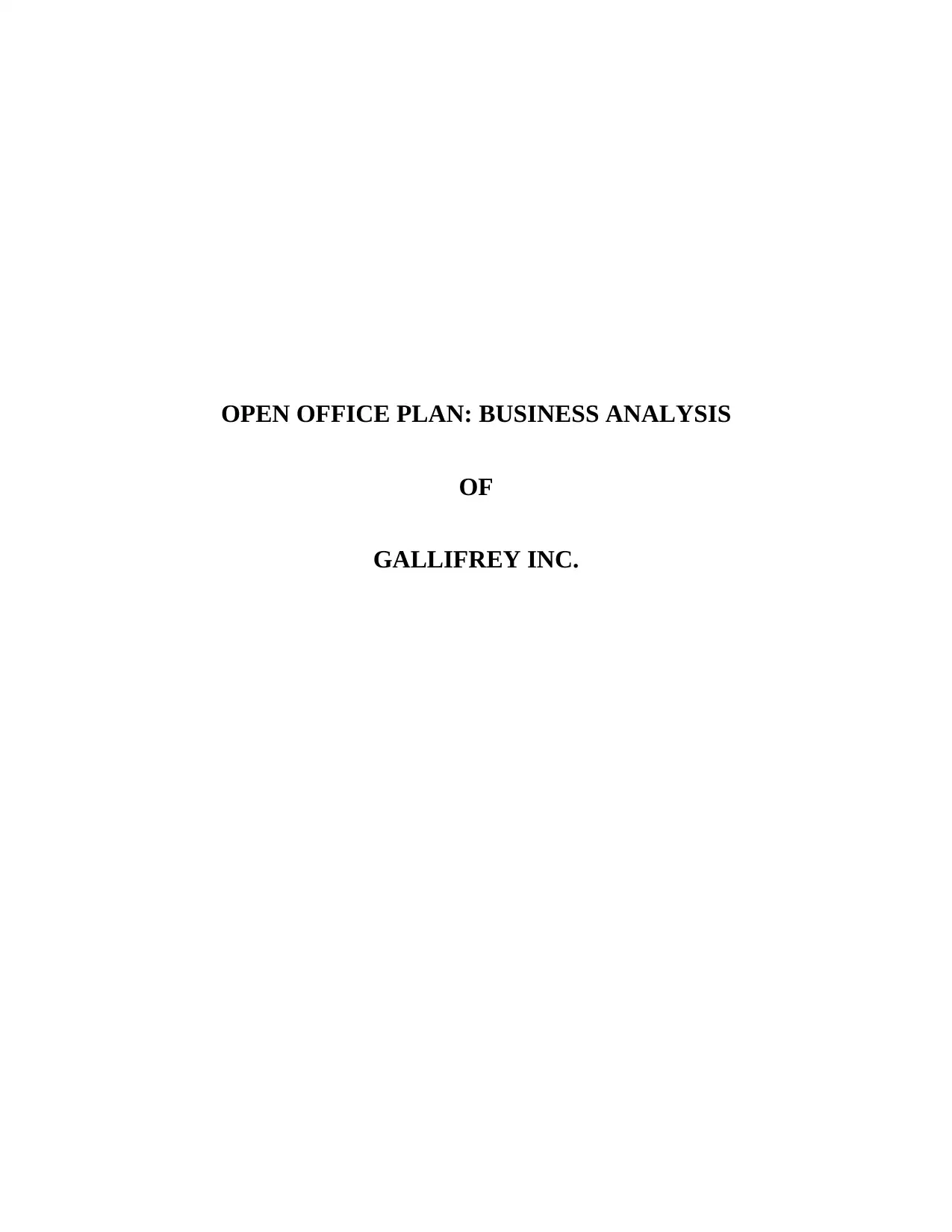
OPEN OFFICE PLAN: BUSINESS ANALYSIS
OF
GALLIFREY INC.
OF
GALLIFREY INC.
Paraphrase This Document
Need a fresh take? Get an instant paraphrase of this document with our AI Paraphraser
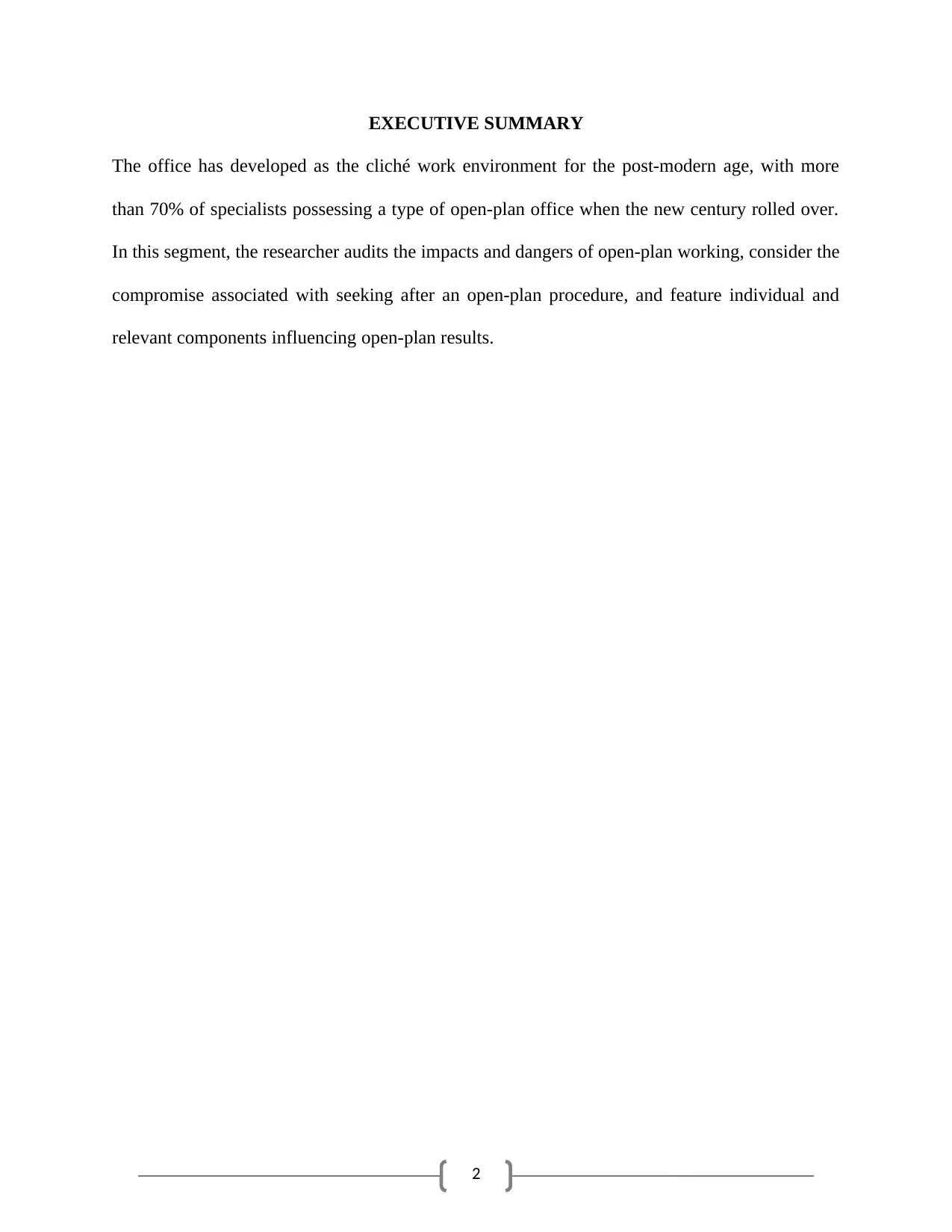
2
EXECUTIVE SUMMARY
The office has developed as the cliché work environment for the post-modern age, with more
than 70% of specialists possessing a type of open-plan office when the new century rolled over.
In this segment, the researcher audits the impacts and dangers of open-plan working, consider the
compromise associated with seeking after an open-plan procedure, and feature individual and
relevant components influencing open-plan results.
EXECUTIVE SUMMARY
The office has developed as the cliché work environment for the post-modern age, with more
than 70% of specialists possessing a type of open-plan office when the new century rolled over.
In this segment, the researcher audits the impacts and dangers of open-plan working, consider the
compromise associated with seeking after an open-plan procedure, and feature individual and
relevant components influencing open-plan results.
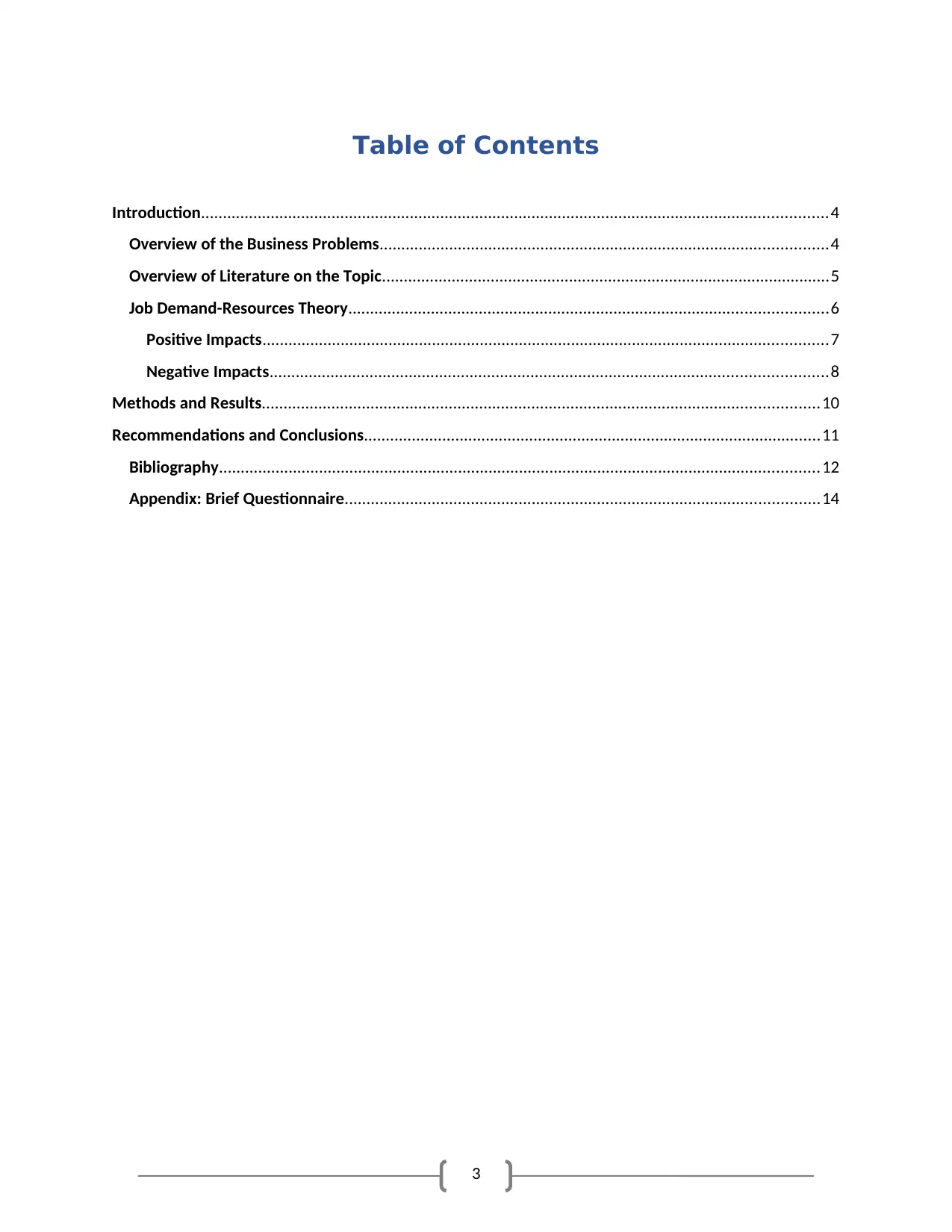
3
Table of Contents
Introduction................................................................................................................................................4
Overview of the Business Problems.......................................................................................................4
Overview of Literature on the Topic.......................................................................................................5
Job Demand-Resources Theory..............................................................................................................6
Positive Impacts..................................................................................................................................7
Negative Impacts................................................................................................................................8
Methods and Results................................................................................................................................10
Recommendations and Conclusions.........................................................................................................11
Bibliography..........................................................................................................................................12
Appendix: Brief Questionnaire.............................................................................................................14
Table of Contents
Introduction................................................................................................................................................4
Overview of the Business Problems.......................................................................................................4
Overview of Literature on the Topic.......................................................................................................5
Job Demand-Resources Theory..............................................................................................................6
Positive Impacts..................................................................................................................................7
Negative Impacts................................................................................................................................8
Methods and Results................................................................................................................................10
Recommendations and Conclusions.........................................................................................................11
Bibliography..........................................................................................................................................12
Appendix: Brief Questionnaire.............................................................................................................14
⊘ This is a preview!⊘
Do you want full access?
Subscribe today to unlock all pages.

Trusted by 1+ million students worldwide
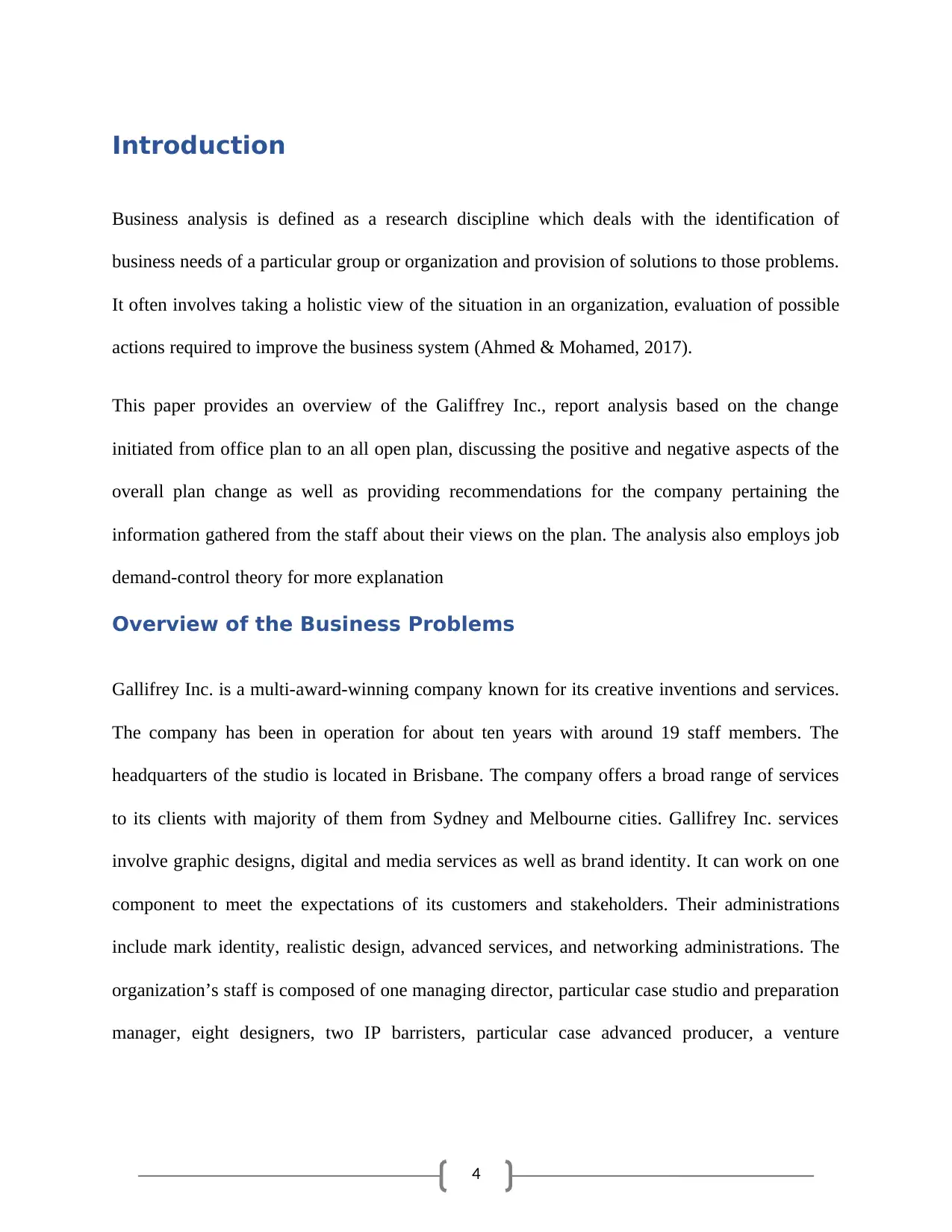
4
Introduction
Business analysis is defined as a research discipline which deals with the identification of
business needs of a particular group or organization and provision of solutions to those problems.
It often involves taking a holistic view of the situation in an organization, evaluation of possible
actions required to improve the business system (Ahmed & Mohamed, 2017).
This paper provides an overview of the Galiffrey Inc., report analysis based on the change
initiated from office plan to an all open plan, discussing the positive and negative aspects of the
overall plan change as well as providing recommendations for the company pertaining the
information gathered from the staff about their views on the plan. The analysis also employs job
demand-control theory for more explanation
Overview of the Business Problems
Gallifrey Inc. is a multi-award-winning company known for its creative inventions and services.
The company has been in operation for about ten years with around 19 staff members. The
headquarters of the studio is located in Brisbane. The company offers a broad range of services
to its clients with majority of them from Sydney and Melbourne cities. Gallifrey Inc. services
involve graphic designs, digital and media services as well as brand identity. It can work on one
component to meet the expectations of its customers and stakeholders. Their administrations
include mark identity, realistic design, advanced services, and networking administrations. The
organization’s staff is composed of one managing director, particular case studio and preparation
manager, eight designers, two IP barristers, particular case advanced producer, a venture
Introduction
Business analysis is defined as a research discipline which deals with the identification of
business needs of a particular group or organization and provision of solutions to those problems.
It often involves taking a holistic view of the situation in an organization, evaluation of possible
actions required to improve the business system (Ahmed & Mohamed, 2017).
This paper provides an overview of the Galiffrey Inc., report analysis based on the change
initiated from office plan to an all open plan, discussing the positive and negative aspects of the
overall plan change as well as providing recommendations for the company pertaining the
information gathered from the staff about their views on the plan. The analysis also employs job
demand-control theory for more explanation
Overview of the Business Problems
Gallifrey Inc. is a multi-award-winning company known for its creative inventions and services.
The company has been in operation for about ten years with around 19 staff members. The
headquarters of the studio is located in Brisbane. The company offers a broad range of services
to its clients with majority of them from Sydney and Melbourne cities. Gallifrey Inc. services
involve graphic designs, digital and media services as well as brand identity. It can work on one
component to meet the expectations of its customers and stakeholders. Their administrations
include mark identity, realistic design, advanced services, and networking administrations. The
organization’s staff is composed of one managing director, particular case studio and preparation
manager, eight designers, two IP barristers, particular case advanced producer, a venture
Paraphrase This Document
Need a fresh take? Get an instant paraphrase of this document with our AI Paraphraser
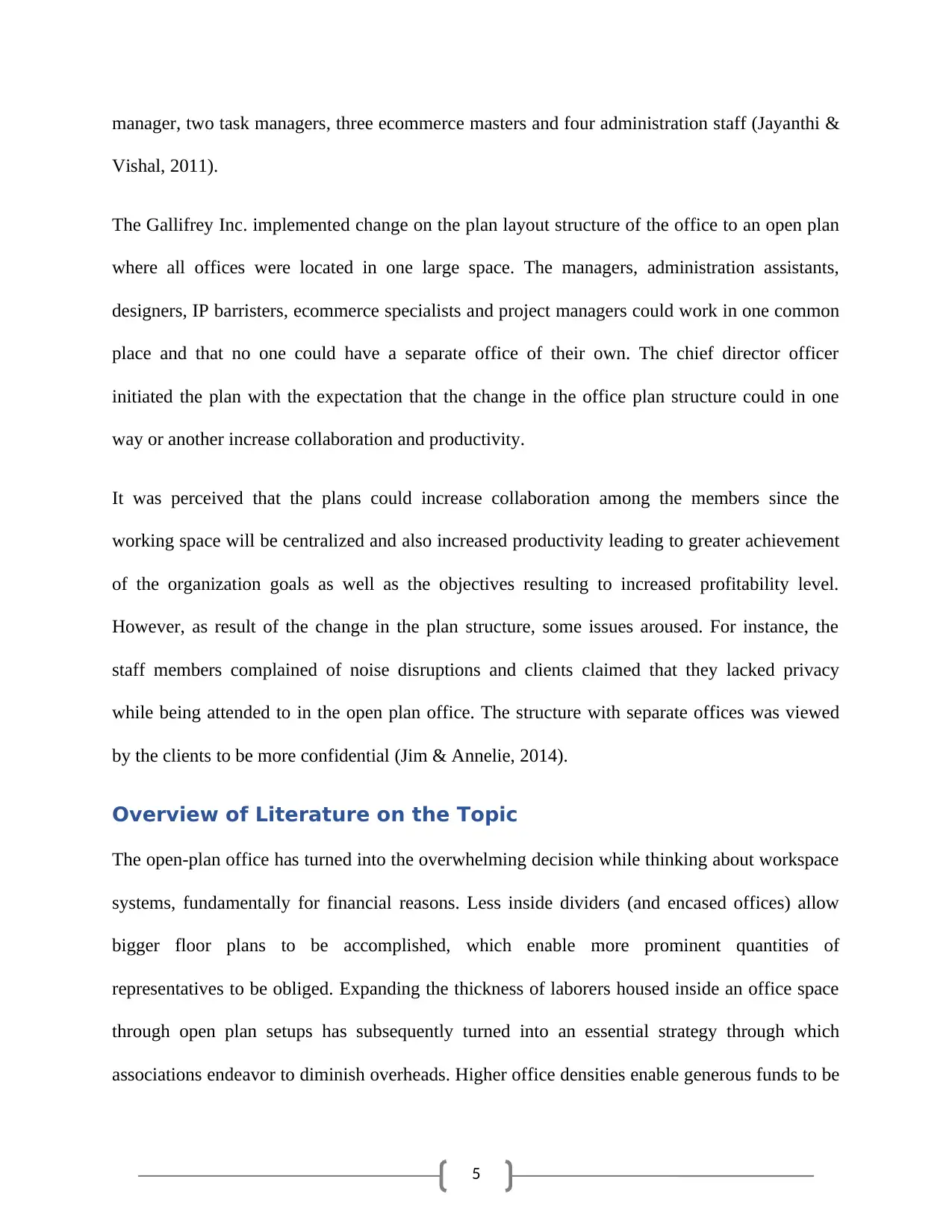
5
manager, two task managers, three ecommerce masters and four administration staff (Jayanthi &
Vishal, 2011).
The Gallifrey Inc. implemented change on the plan layout structure of the office to an open plan
where all offices were located in one large space. The managers, administration assistants,
designers, IP barristers, ecommerce specialists and project managers could work in one common
place and that no one could have a separate office of their own. The chief director officer
initiated the plan with the expectation that the change in the office plan structure could in one
way or another increase collaboration and productivity.
It was perceived that the plans could increase collaboration among the members since the
working space will be centralized and also increased productivity leading to greater achievement
of the organization goals as well as the objectives resulting to increased profitability level.
However, as result of the change in the plan structure, some issues aroused. For instance, the
staff members complained of noise disruptions and clients claimed that they lacked privacy
while being attended to in the open plan office. The structure with separate offices was viewed
by the clients to be more confidential (Jim & Annelie, 2014).
Overview of Literature on the Topic
The open-plan office has turned into the overwhelming decision while thinking about workspace
systems, fundamentally for financial reasons. Less inside dividers (and encased offices) allow
bigger floor plans to be accomplished, which enable more prominent quantities of
representatives to be obliged. Expanding the thickness of laborers housed inside an office space
through open plan setups has subsequently turned into an essential strategy through which
associations endeavor to diminish overheads. Higher office densities enable generous funds to be
manager, two task managers, three ecommerce masters and four administration staff (Jayanthi &
Vishal, 2011).
The Gallifrey Inc. implemented change on the plan layout structure of the office to an open plan
where all offices were located in one large space. The managers, administration assistants,
designers, IP barristers, ecommerce specialists and project managers could work in one common
place and that no one could have a separate office of their own. The chief director officer
initiated the plan with the expectation that the change in the office plan structure could in one
way or another increase collaboration and productivity.
It was perceived that the plans could increase collaboration among the members since the
working space will be centralized and also increased productivity leading to greater achievement
of the organization goals as well as the objectives resulting to increased profitability level.
However, as result of the change in the plan structure, some issues aroused. For instance, the
staff members complained of noise disruptions and clients claimed that they lacked privacy
while being attended to in the open plan office. The structure with separate offices was viewed
by the clients to be more confidential (Jim & Annelie, 2014).
Overview of Literature on the Topic
The open-plan office has turned into the overwhelming decision while thinking about workspace
systems, fundamentally for financial reasons. Less inside dividers (and encased offices) allow
bigger floor plans to be accomplished, which enable more prominent quantities of
representatives to be obliged. Expanding the thickness of laborers housed inside an office space
through open plan setups has subsequently turned into an essential strategy through which
associations endeavor to diminish overheads. Higher office densities enable generous funds to be

6
made in either rental, land or fabricate expenses and lower services (e.g., warming and
ventilation) and security charges. Mirroring these reserve funds, the most recent figures
demonstrate a 40% expansion in normal office compactness (Liwen & Jingkun, 2015).
Cost reserve funds can likewise be acknowledged through an expansion in adaptability. It is far
simpler to move furniture around in an extensive open-plan office than inside encased offices.
This adaptability decreases the expenses of future rearrangements, with work areas promptly
rearranged as individual and authoritative necessities change, for instance, undertaking groups
change or new innovation is required. People and groups can likewise be sorted out around work
processes and departmental groupings, empowering justifications, for example, the brought
together capacity of gathering documents and work material.
Job Demand-Resources Theory
This theory deals with occupational stress of an employee which is related to job demands and
resources. This model incorporates the working conditions of a particular organization and
employee expectations. Unlike the other models, this theory applies to all job specifications. The
assumption of this model is centered around job demands and job resources. Job demands relate
to the physical or organizational aspects that require employee effort or skills indoor to be
sustained whereas job resources are associated with factors such as emotional demand and work
pressure. Job resources refer to those essentials needed to achieve organizational goals, stimulate
growth and facilitate learning and development (Maiorescu, 2017).
For instance, employees engage more in work when the work place resources are favorable. The
physical and social resources are both necessary for employee well-being and engagement. The
Galiffrey Inc. changed its office structure to an open plan system, this however varied the
resources available for the employees leading to both positive and negative outcomes. Job
made in either rental, land or fabricate expenses and lower services (e.g., warming and
ventilation) and security charges. Mirroring these reserve funds, the most recent figures
demonstrate a 40% expansion in normal office compactness (Liwen & Jingkun, 2015).
Cost reserve funds can likewise be acknowledged through an expansion in adaptability. It is far
simpler to move furniture around in an extensive open-plan office than inside encased offices.
This adaptability decreases the expenses of future rearrangements, with work areas promptly
rearranged as individual and authoritative necessities change, for instance, undertaking groups
change or new innovation is required. People and groups can likewise be sorted out around work
processes and departmental groupings, empowering justifications, for example, the brought
together capacity of gathering documents and work material.
Job Demand-Resources Theory
This theory deals with occupational stress of an employee which is related to job demands and
resources. This model incorporates the working conditions of a particular organization and
employee expectations. Unlike the other models, this theory applies to all job specifications. The
assumption of this model is centered around job demands and job resources. Job demands relate
to the physical or organizational aspects that require employee effort or skills indoor to be
sustained whereas job resources are associated with factors such as emotional demand and work
pressure. Job resources refer to those essentials needed to achieve organizational goals, stimulate
growth and facilitate learning and development (Maiorescu, 2017).
For instance, employees engage more in work when the work place resources are favorable. The
physical and social resources are both necessary for employee well-being and engagement. The
Galiffrey Inc. changed its office structure to an open plan system, this however varied the
resources available for the employees leading to both positive and negative outcomes. Job
⊘ This is a preview!⊘
Do you want full access?
Subscribe today to unlock all pages.

Trusted by 1+ million students worldwide
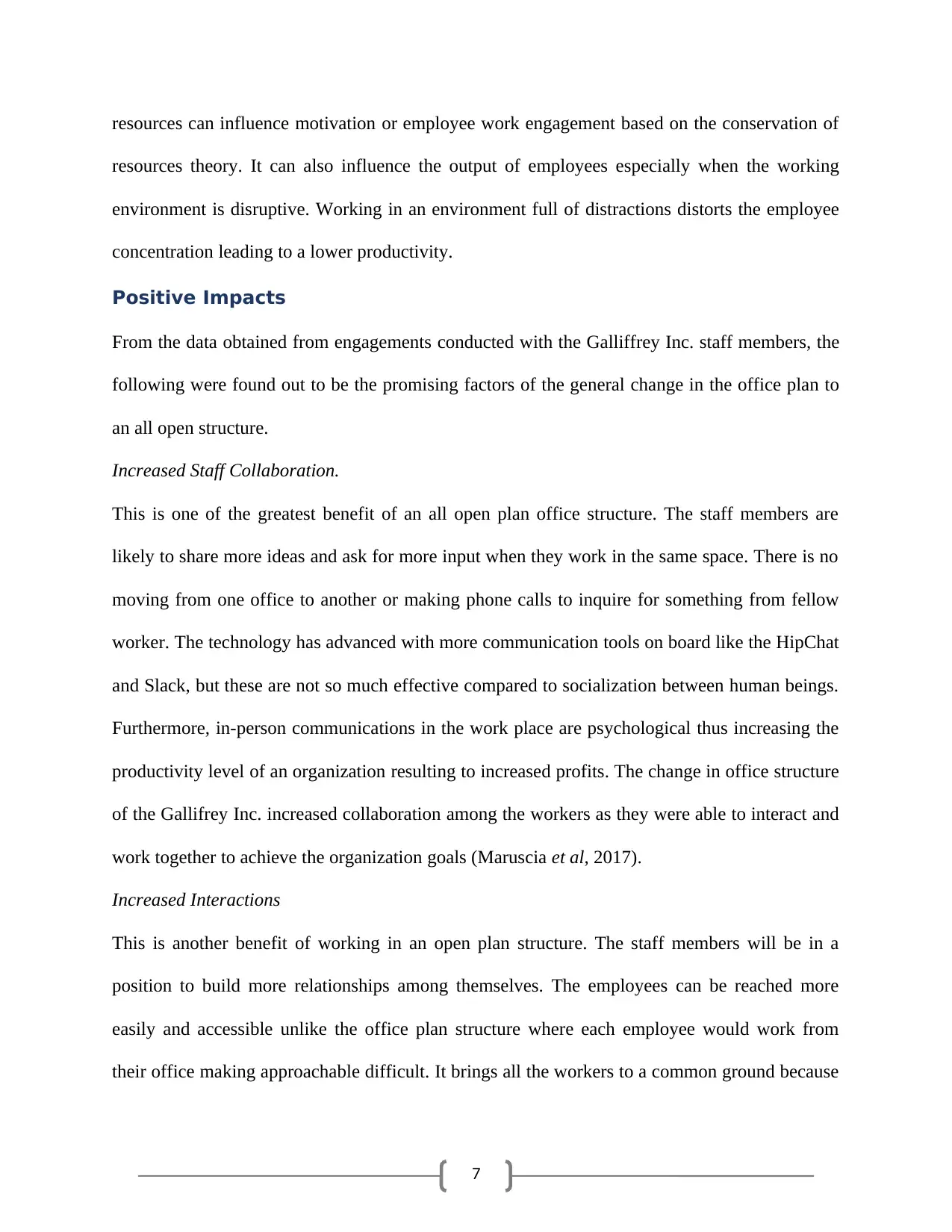
7
resources can influence motivation or employee work engagement based on the conservation of
resources theory. It can also influence the output of employees especially when the working
environment is disruptive. Working in an environment full of distractions distorts the employee
concentration leading to a lower productivity.
Positive Impacts
From the data obtained from engagements conducted with the Galliffrey Inc. staff members, the
following were found out to be the promising factors of the general change in the office plan to
an all open structure.
Increased Staff Collaboration.
This is one of the greatest benefit of an all open plan office structure. The staff members are
likely to share more ideas and ask for more input when they work in the same space. There is no
moving from one office to another or making phone calls to inquire for something from fellow
worker. The technology has advanced with more communication tools on board like the HipChat
and Slack, but these are not so much effective compared to socialization between human beings.
Furthermore, in-person communications in the work place are psychological thus increasing the
productivity level of an organization resulting to increased profits. The change in office structure
of the Gallifrey Inc. increased collaboration among the workers as they were able to interact and
work together to achieve the organization goals (Maruscia et al, 2017).
Increased Interactions
This is another benefit of working in an open plan structure. The staff members will be in a
position to build more relationships among themselves. The employees can be reached more
easily and accessible unlike the office plan structure where each employee would work from
their office making approachable difficult. It brings all the workers to a common ground because
resources can influence motivation or employee work engagement based on the conservation of
resources theory. It can also influence the output of employees especially when the working
environment is disruptive. Working in an environment full of distractions distorts the employee
concentration leading to a lower productivity.
Positive Impacts
From the data obtained from engagements conducted with the Galliffrey Inc. staff members, the
following were found out to be the promising factors of the general change in the office plan to
an all open structure.
Increased Staff Collaboration.
This is one of the greatest benefit of an all open plan office structure. The staff members are
likely to share more ideas and ask for more input when they work in the same space. There is no
moving from one office to another or making phone calls to inquire for something from fellow
worker. The technology has advanced with more communication tools on board like the HipChat
and Slack, but these are not so much effective compared to socialization between human beings.
Furthermore, in-person communications in the work place are psychological thus increasing the
productivity level of an organization resulting to increased profits. The change in office structure
of the Gallifrey Inc. increased collaboration among the workers as they were able to interact and
work together to achieve the organization goals (Maruscia et al, 2017).
Increased Interactions
This is another benefit of working in an open plan structure. The staff members will be in a
position to build more relationships among themselves. The employees can be reached more
easily and accessible unlike the office plan structure where each employee would work from
their office making approachable difficult. It brings all the workers to a common ground because
Paraphrase This Document
Need a fresh take? Get an instant paraphrase of this document with our AI Paraphraser
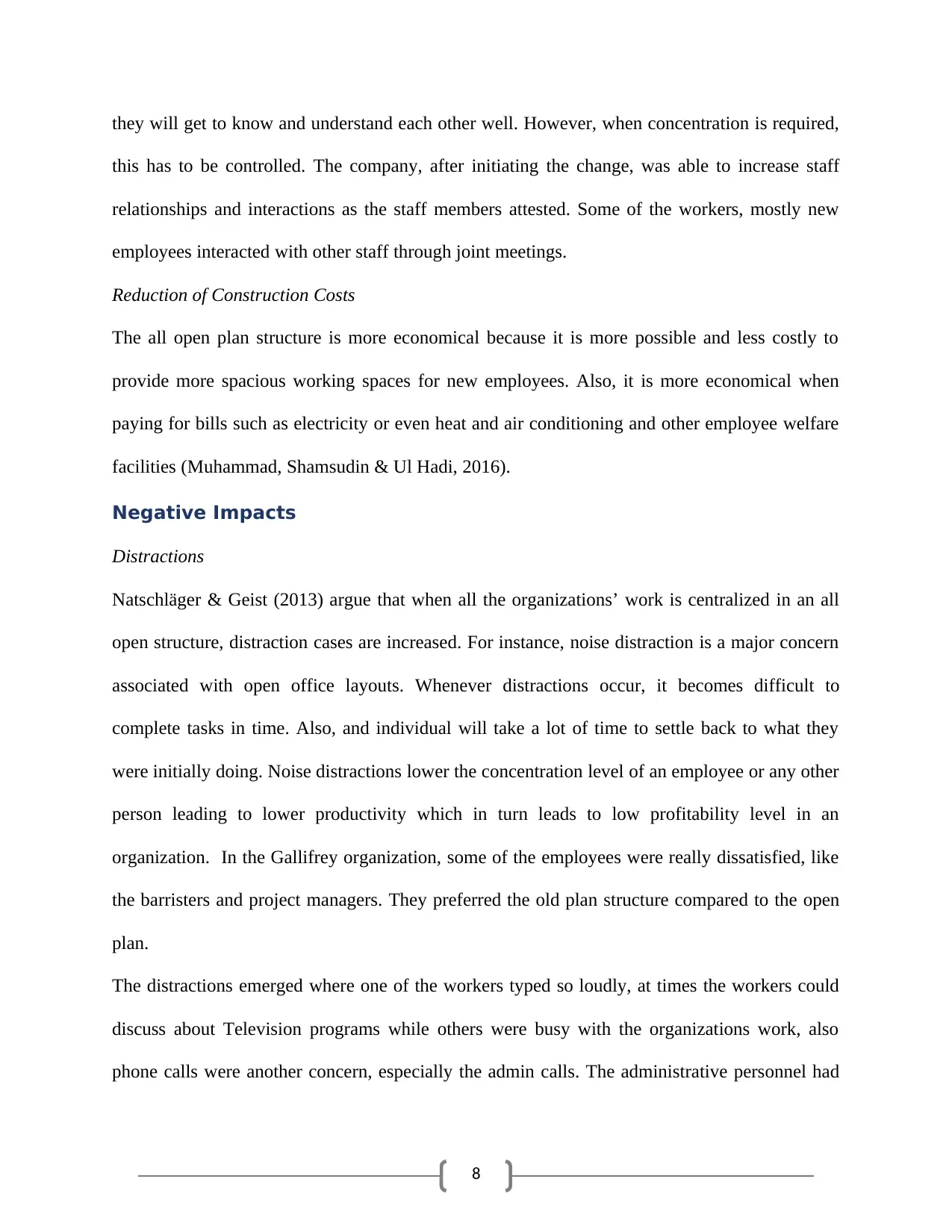
8
they will get to know and understand each other well. However, when concentration is required,
this has to be controlled. The company, after initiating the change, was able to increase staff
relationships and interactions as the staff members attested. Some of the workers, mostly new
employees interacted with other staff through joint meetings.
Reduction of Construction Costs
The all open plan structure is more economical because it is more possible and less costly to
provide more spacious working spaces for new employees. Also, it is more economical when
paying for bills such as electricity or even heat and air conditioning and other employee welfare
facilities (Muhammad, Shamsudin & Ul Hadi, 2016).
Negative Impacts
Distractions
Natschläger & Geist (2013) argue that when all the organizations’ work is centralized in an all
open structure, distraction cases are increased. For instance, noise distraction is a major concern
associated with open office layouts. Whenever distractions occur, it becomes difficult to
complete tasks in time. Also, and individual will take a lot of time to settle back to what they
were initially doing. Noise distractions lower the concentration level of an employee or any other
person leading to lower productivity which in turn leads to low profitability level in an
organization. In the Gallifrey organization, some of the employees were really dissatisfied, like
the barristers and project managers. They preferred the old plan structure compared to the open
plan.
The distractions emerged where one of the workers typed so loudly, at times the workers could
discuss about Television programs while others were busy with the organizations work, also
phone calls were another concern, especially the admin calls. The administrative personnel had
they will get to know and understand each other well. However, when concentration is required,
this has to be controlled. The company, after initiating the change, was able to increase staff
relationships and interactions as the staff members attested. Some of the workers, mostly new
employees interacted with other staff through joint meetings.
Reduction of Construction Costs
The all open plan structure is more economical because it is more possible and less costly to
provide more spacious working spaces for new employees. Also, it is more economical when
paying for bills such as electricity or even heat and air conditioning and other employee welfare
facilities (Muhammad, Shamsudin & Ul Hadi, 2016).
Negative Impacts
Distractions
Natschläger & Geist (2013) argue that when all the organizations’ work is centralized in an all
open structure, distraction cases are increased. For instance, noise distraction is a major concern
associated with open office layouts. Whenever distractions occur, it becomes difficult to
complete tasks in time. Also, and individual will take a lot of time to settle back to what they
were initially doing. Noise distractions lower the concentration level of an employee or any other
person leading to lower productivity which in turn leads to low profitability level in an
organization. In the Gallifrey organization, some of the employees were really dissatisfied, like
the barristers and project managers. They preferred the old plan structure compared to the open
plan.
The distractions emerged where one of the workers typed so loudly, at times the workers could
discuss about Television programs while others were busy with the organizations work, also
phone calls were another concern, especially the admin calls. The administrative personnel had
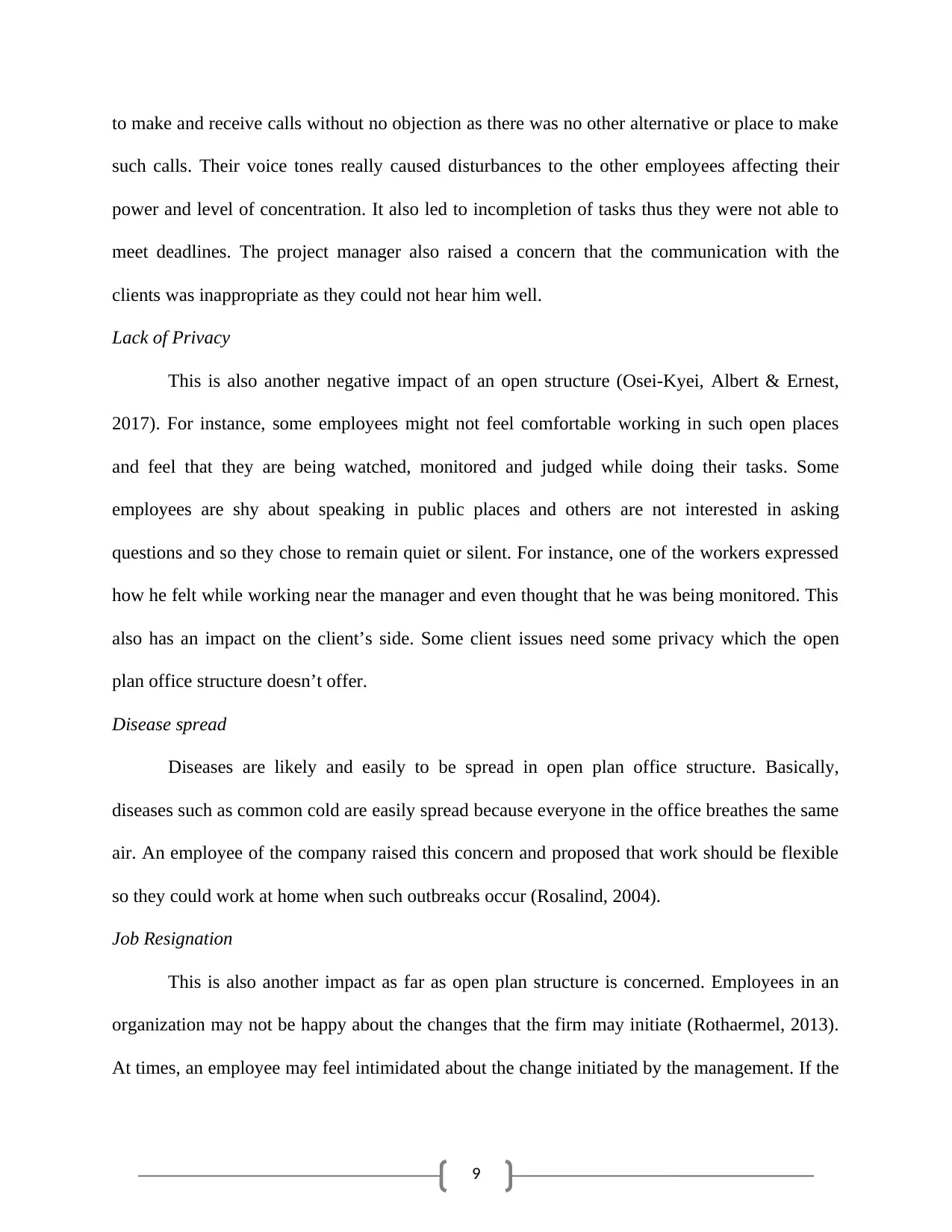
9
to make and receive calls without no objection as there was no other alternative or place to make
such calls. Their voice tones really caused disturbances to the other employees affecting their
power and level of concentration. It also led to incompletion of tasks thus they were not able to
meet deadlines. The project manager also raised a concern that the communication with the
clients was inappropriate as they could not hear him well.
Lack of Privacy
This is also another negative impact of an open structure (Osei-Kyei, Albert & Ernest,
2017). For instance, some employees might not feel comfortable working in such open places
and feel that they are being watched, monitored and judged while doing their tasks. Some
employees are shy about speaking in public places and others are not interested in asking
questions and so they chose to remain quiet or silent. For instance, one of the workers expressed
how he felt while working near the manager and even thought that he was being monitored. This
also has an impact on the client’s side. Some client issues need some privacy which the open
plan office structure doesn’t offer.
Disease spread
Diseases are likely and easily to be spread in open plan office structure. Basically,
diseases such as common cold are easily spread because everyone in the office breathes the same
air. An employee of the company raised this concern and proposed that work should be flexible
so they could work at home when such outbreaks occur (Rosalind, 2004).
Job Resignation
This is also another impact as far as open plan structure is concerned. Employees in an
organization may not be happy about the changes that the firm may initiate (Rothaermel, 2013).
At times, an employee may feel intimidated about the change initiated by the management. If the
to make and receive calls without no objection as there was no other alternative or place to make
such calls. Their voice tones really caused disturbances to the other employees affecting their
power and level of concentration. It also led to incompletion of tasks thus they were not able to
meet deadlines. The project manager also raised a concern that the communication with the
clients was inappropriate as they could not hear him well.
Lack of Privacy
This is also another negative impact of an open structure (Osei-Kyei, Albert & Ernest,
2017). For instance, some employees might not feel comfortable working in such open places
and feel that they are being watched, monitored and judged while doing their tasks. Some
employees are shy about speaking in public places and others are not interested in asking
questions and so they chose to remain quiet or silent. For instance, one of the workers expressed
how he felt while working near the manager and even thought that he was being monitored. This
also has an impact on the client’s side. Some client issues need some privacy which the open
plan office structure doesn’t offer.
Disease spread
Diseases are likely and easily to be spread in open plan office structure. Basically,
diseases such as common cold are easily spread because everyone in the office breathes the same
air. An employee of the company raised this concern and proposed that work should be flexible
so they could work at home when such outbreaks occur (Rosalind, 2004).
Job Resignation
This is also another impact as far as open plan structure is concerned. Employees in an
organization may not be happy about the changes that the firm may initiate (Rothaermel, 2013).
At times, an employee may feel intimidated about the change initiated by the management. If the
⊘ This is a preview!⊘
Do you want full access?
Subscribe today to unlock all pages.

Trusted by 1+ million students worldwide
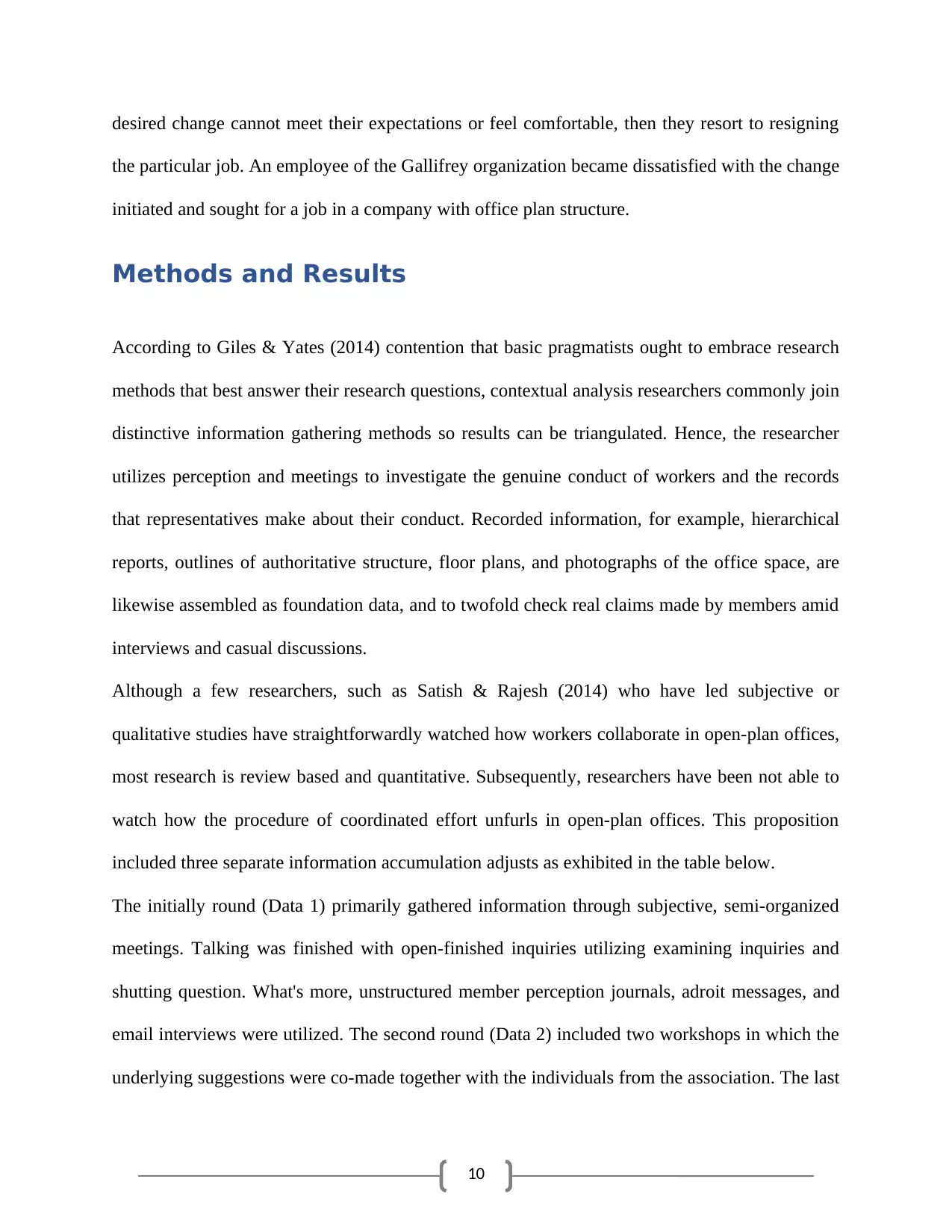
10
desired change cannot meet their expectations or feel comfortable, then they resort to resigning
the particular job. An employee of the Gallifrey organization became dissatisfied with the change
initiated and sought for a job in a company with office plan structure.
Methods and Results
According to Giles & Yates (2014) contention that basic pragmatists ought to embrace research
methods that best answer their research questions, contextual analysis researchers commonly join
distinctive information gathering methods so results can be triangulated. Hence, the researcher
utilizes perception and meetings to investigate the genuine conduct of workers and the records
that representatives make about their conduct. Recorded information, for example, hierarchical
reports, outlines of authoritative structure, floor plans, and photographs of the office space, are
likewise assembled as foundation data, and to twofold check real claims made by members amid
interviews and casual discussions.
Although a few researchers, such as Satish & Rajesh (2014) who have led subjective or
qualitative studies have straightforwardly watched how workers collaborate in open-plan offices,
most research is review based and quantitative. Subsequently, researchers have been not able to
watch how the procedure of coordinated effort unfurls in open-plan offices. This proposition
included three separate information accumulation adjusts as exhibited in the table below.
The initially round (Data 1) primarily gathered information through subjective, semi-organized
meetings. Talking was finished with open-finished inquiries utilizing examining inquiries and
shutting question. What's more, unstructured member perception journals, adroit messages, and
email interviews were utilized. The second round (Data 2) included two workshops in which the
underlying suggestions were co-made together with the individuals from the association. The last
desired change cannot meet their expectations or feel comfortable, then they resort to resigning
the particular job. An employee of the Gallifrey organization became dissatisfied with the change
initiated and sought for a job in a company with office plan structure.
Methods and Results
According to Giles & Yates (2014) contention that basic pragmatists ought to embrace research
methods that best answer their research questions, contextual analysis researchers commonly join
distinctive information gathering methods so results can be triangulated. Hence, the researcher
utilizes perception and meetings to investigate the genuine conduct of workers and the records
that representatives make about their conduct. Recorded information, for example, hierarchical
reports, outlines of authoritative structure, floor plans, and photographs of the office space, are
likewise assembled as foundation data, and to twofold check real claims made by members amid
interviews and casual discussions.
Although a few researchers, such as Satish & Rajesh (2014) who have led subjective or
qualitative studies have straightforwardly watched how workers collaborate in open-plan offices,
most research is review based and quantitative. Subsequently, researchers have been not able to
watch how the procedure of coordinated effort unfurls in open-plan offices. This proposition
included three separate information accumulation adjusts as exhibited in the table below.
The initially round (Data 1) primarily gathered information through subjective, semi-organized
meetings. Talking was finished with open-finished inquiries utilizing examining inquiries and
shutting question. What's more, unstructured member perception journals, adroit messages, and
email interviews were utilized. The second round (Data 2) included two workshops in which the
underlying suggestions were co-made together with the individuals from the association. The last
Paraphrase This Document
Need a fresh take? Get an instant paraphrase of this document with our AI Paraphraser
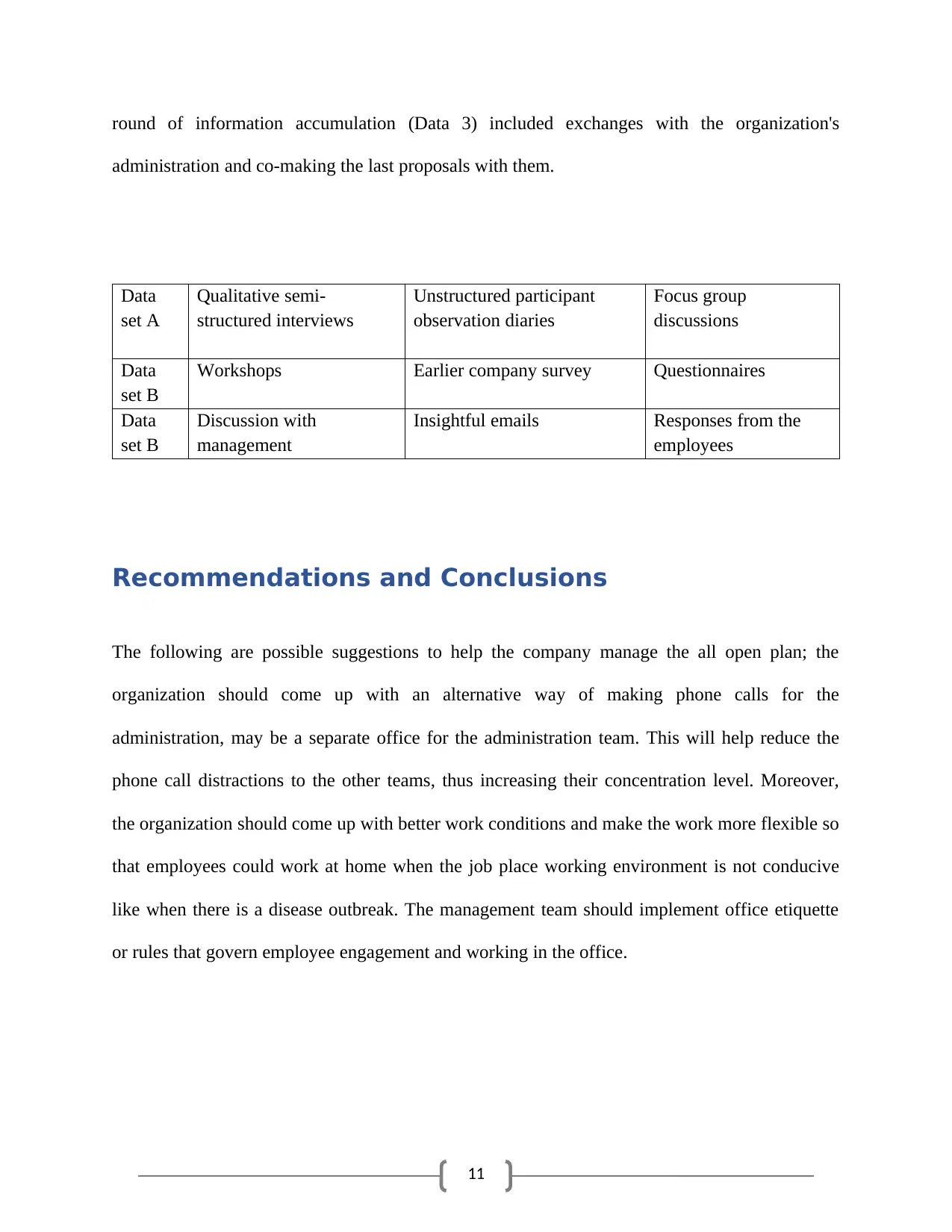
11
round of information accumulation (Data 3) included exchanges with the organization's
administration and co-making the last proposals with them.
Data
set A
Qualitative semi-
structured interviews
Unstructured participant
observation diaries
Focus group
discussions
Data
set B
Workshops Earlier company survey Questionnaires
Data
set B
Discussion with
management
Insightful emails Responses from the
employees
Recommendations and Conclusions
The following are possible suggestions to help the company manage the all open plan; the
organization should come up with an alternative way of making phone calls for the
administration, may be a separate office for the administration team. This will help reduce the
phone call distractions to the other teams, thus increasing their concentration level. Moreover,
the organization should come up with better work conditions and make the work more flexible so
that employees could work at home when the job place working environment is not conducive
like when there is a disease outbreak. The management team should implement office etiquette
or rules that govern employee engagement and working in the office.
round of information accumulation (Data 3) included exchanges with the organization's
administration and co-making the last proposals with them.
Data
set A
Qualitative semi-
structured interviews
Unstructured participant
observation diaries
Focus group
discussions
Data
set B
Workshops Earlier company survey Questionnaires
Data
set B
Discussion with
management
Insightful emails Responses from the
employees
Recommendations and Conclusions
The following are possible suggestions to help the company manage the all open plan; the
organization should come up with an alternative way of making phone calls for the
administration, may be a separate office for the administration team. This will help reduce the
phone call distractions to the other teams, thus increasing their concentration level. Moreover,
the organization should come up with better work conditions and make the work more flexible so
that employees could work at home when the job place working environment is not conducive
like when there is a disease outbreak. The management team should implement office etiquette
or rules that govern employee engagement and working in the office.
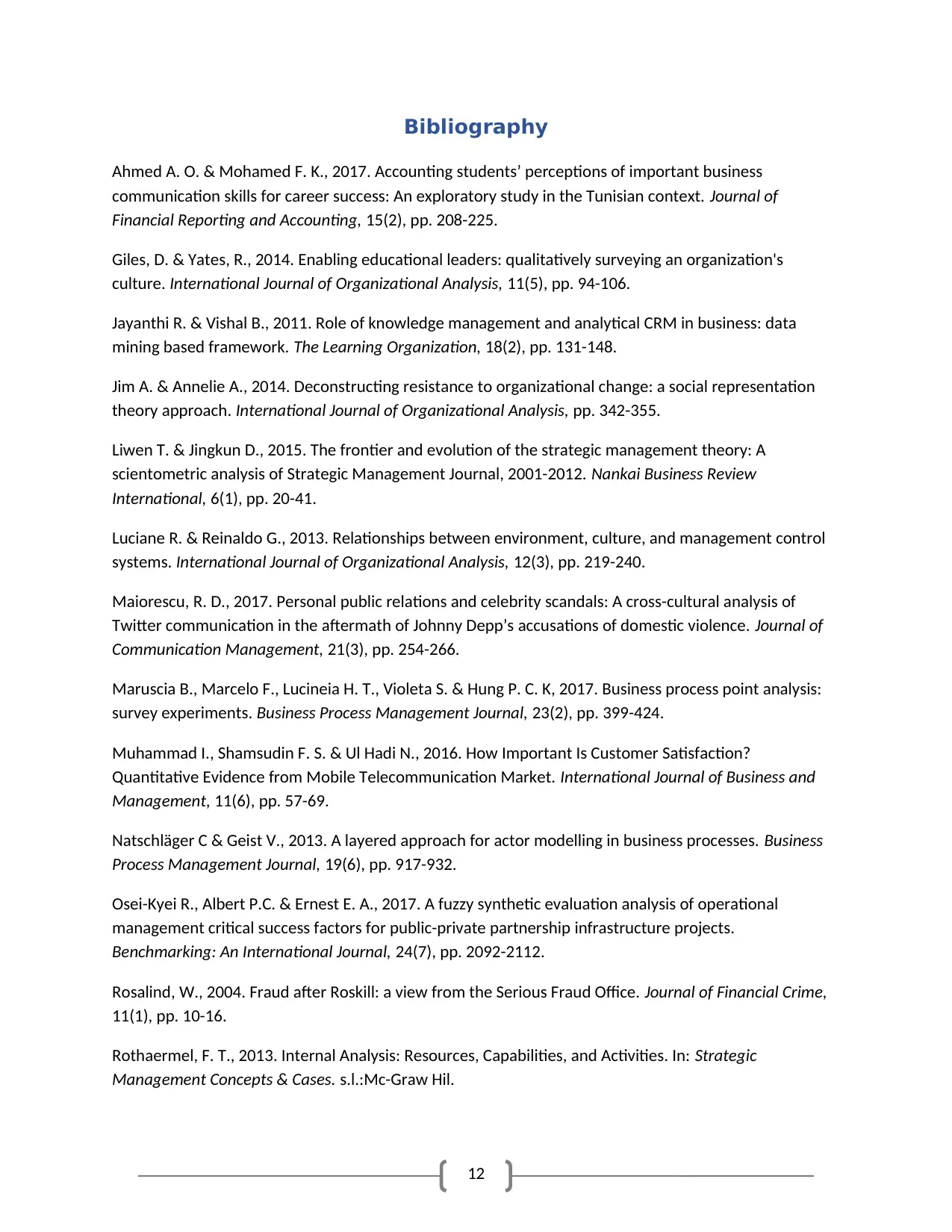
12
Bibliography
Ahmed A. O. & Mohamed F. K., 2017. Accounting students’ perceptions of important business
communication skills for career success: An exploratory study in the Tunisian context. Journal of
Financial Reporting and Accounting, 15(2), pp. 208-225.
Giles, D. & Yates, R., 2014. Enabling educational leaders: qualitatively surveying an organization's
culture. International Journal of Organizational Analysis, 11(5), pp. 94-106.
Jayanthi R. & Vishal B., 2011. Role of knowledge management and analytical CRM in business: data
mining based framework. The Learning Organization, 18(2), pp. 131-148.
Jim A. & Annelie A., 2014. Deconstructing resistance to organizational change: a social representation
theory approach. International Journal of Organizational Analysis, pp. 342-355.
Liwen T. & Jingkun D., 2015. The frontier and evolution of the strategic management theory: A
scientometric analysis of Strategic Management Journal, 2001-2012. Nankai Business Review
International, 6(1), pp. 20-41.
Luciane R. & Reinaldo G., 2013. Relationships between environment, culture, and management control
systems. International Journal of Organizational Analysis, 12(3), pp. 219-240.
Maiorescu, R. D., 2017. Personal public relations and celebrity scandals: A cross-cultural analysis of
Twitter communication in the aftermath of Johnny Depp’s accusations of domestic violence. Journal of
Communication Management, 21(3), pp. 254-266.
Maruscia B., Marcelo F., Lucineia H. T., Violeta S. & Hung P. C. K, 2017. Business process point analysis:
survey experiments. Business Process Management Journal, 23(2), pp. 399-424.
Muhammad I., Shamsudin F. S. & Ul Hadi N., 2016. How Important Is Customer Satisfaction?
Quantitative Evidence from Mobile Telecommunication Market. International Journal of Business and
Management, 11(6), pp. 57-69.
Natschläger C & Geist V., 2013. A layered approach for actor modelling in business processes. Business
Process Management Journal, 19(6), pp. 917-932.
Osei-Kyei R., Albert P.C. & Ernest E. A., 2017. A fuzzy synthetic evaluation analysis of operational
management critical success factors for public-private partnership infrastructure projects.
Benchmarking: An International Journal, 24(7), pp. 2092-2112.
Rosalind, W., 2004. Fraud after Roskill: a view from the Serious Fraud Office. Journal of Financial Crime,
11(1), pp. 10-16.
Rothaermel, F. T., 2013. Internal Analysis: Resources, Capabilities, and Activities. In: Strategic
Management Concepts & Cases. s.l.:Mc-Graw Hil.
Bibliography
Ahmed A. O. & Mohamed F. K., 2017. Accounting students’ perceptions of important business
communication skills for career success: An exploratory study in the Tunisian context. Journal of
Financial Reporting and Accounting, 15(2), pp. 208-225.
Giles, D. & Yates, R., 2014. Enabling educational leaders: qualitatively surveying an organization's
culture. International Journal of Organizational Analysis, 11(5), pp. 94-106.
Jayanthi R. & Vishal B., 2011. Role of knowledge management and analytical CRM in business: data
mining based framework. The Learning Organization, 18(2), pp. 131-148.
Jim A. & Annelie A., 2014. Deconstructing resistance to organizational change: a social representation
theory approach. International Journal of Organizational Analysis, pp. 342-355.
Liwen T. & Jingkun D., 2015. The frontier and evolution of the strategic management theory: A
scientometric analysis of Strategic Management Journal, 2001-2012. Nankai Business Review
International, 6(1), pp. 20-41.
Luciane R. & Reinaldo G., 2013. Relationships between environment, culture, and management control
systems. International Journal of Organizational Analysis, 12(3), pp. 219-240.
Maiorescu, R. D., 2017. Personal public relations and celebrity scandals: A cross-cultural analysis of
Twitter communication in the aftermath of Johnny Depp’s accusations of domestic violence. Journal of
Communication Management, 21(3), pp. 254-266.
Maruscia B., Marcelo F., Lucineia H. T., Violeta S. & Hung P. C. K, 2017. Business process point analysis:
survey experiments. Business Process Management Journal, 23(2), pp. 399-424.
Muhammad I., Shamsudin F. S. & Ul Hadi N., 2016. How Important Is Customer Satisfaction?
Quantitative Evidence from Mobile Telecommunication Market. International Journal of Business and
Management, 11(6), pp. 57-69.
Natschläger C & Geist V., 2013. A layered approach for actor modelling in business processes. Business
Process Management Journal, 19(6), pp. 917-932.
Osei-Kyei R., Albert P.C. & Ernest E. A., 2017. A fuzzy synthetic evaluation analysis of operational
management critical success factors for public-private partnership infrastructure projects.
Benchmarking: An International Journal, 24(7), pp. 2092-2112.
Rosalind, W., 2004. Fraud after Roskill: a view from the Serious Fraud Office. Journal of Financial Crime,
11(1), pp. 10-16.
Rothaermel, F. T., 2013. Internal Analysis: Resources, Capabilities, and Activities. In: Strategic
Management Concepts & Cases. s.l.:Mc-Graw Hil.
⊘ This is a preview!⊘
Do you want full access?
Subscribe today to unlock all pages.

Trusted by 1+ million students worldwide
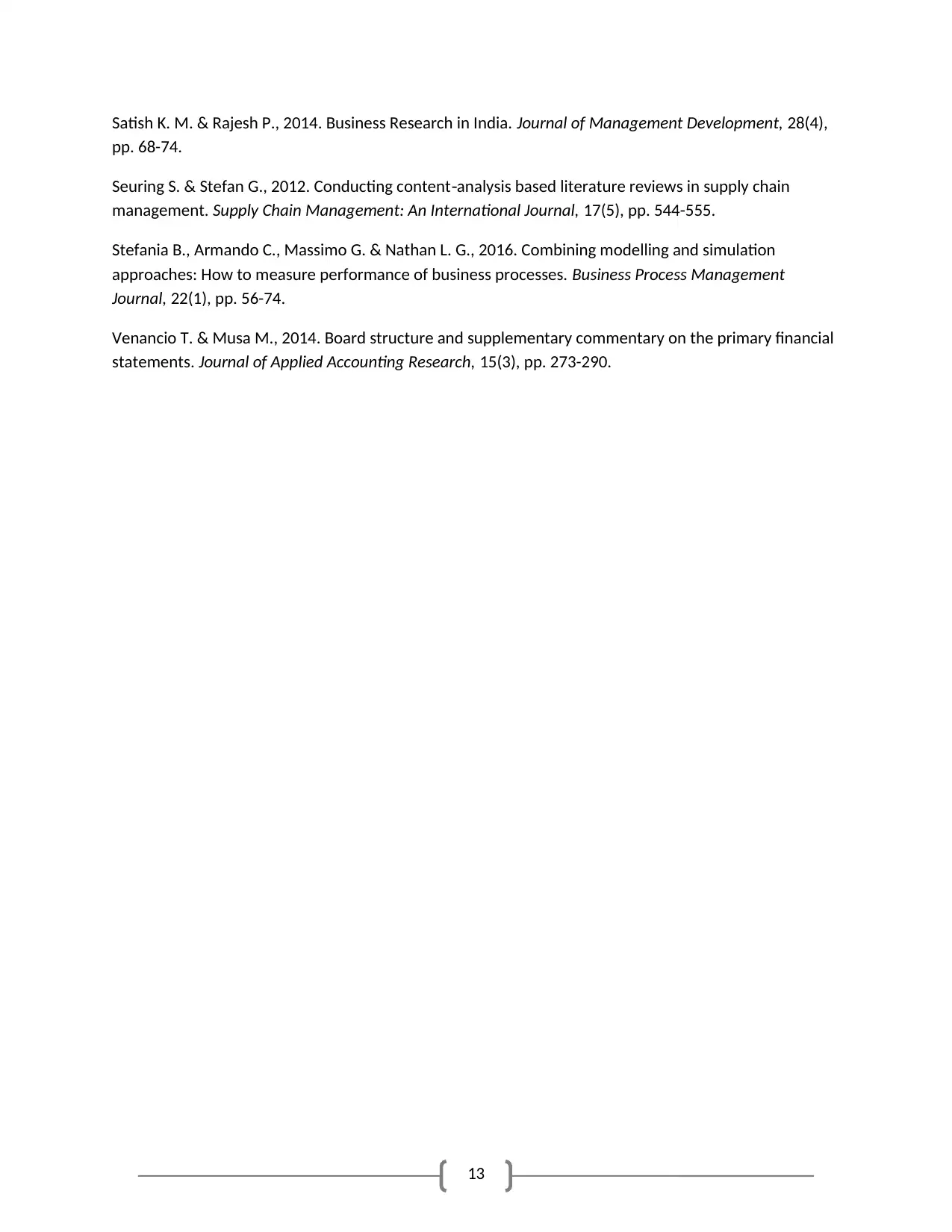
13
Satish K. M. & Rajesh P., 2014. Business Research in India. Journal of Management Development, 28(4),
pp. 68-74.
Seuring S. & Stefan G., 2012. Conducting content analysis based literature reviews in supply chain‐
management. Supply Chain Management: An International Journal, 17(5), pp. 544-555.
Stefania B., Armando C., Massimo G. & Nathan L. G., 2016. Combining modelling and simulation
approaches: How to measure performance of business processes. Business Process Management
Journal, 22(1), pp. 56-74.
Venancio T. & Musa M., 2014. Board structure and supplementary commentary on the primary financial
statements. Journal of Applied Accounting Research, 15(3), pp. 273-290.
Satish K. M. & Rajesh P., 2014. Business Research in India. Journal of Management Development, 28(4),
pp. 68-74.
Seuring S. & Stefan G., 2012. Conducting content analysis based literature reviews in supply chain‐
management. Supply Chain Management: An International Journal, 17(5), pp. 544-555.
Stefania B., Armando C., Massimo G. & Nathan L. G., 2016. Combining modelling and simulation
approaches: How to measure performance of business processes. Business Process Management
Journal, 22(1), pp. 56-74.
Venancio T. & Musa M., 2014. Board structure and supplementary commentary on the primary financial
statements. Journal of Applied Accounting Research, 15(3), pp. 273-290.
Paraphrase This Document
Need a fresh take? Get an instant paraphrase of this document with our AI Paraphraser

14
Appendix: Brief Questionnaire
Your participation in the study is completely voluntary and you may choose to stop participating
at any time. The study will be completely confidential. At no point in time will your real name or
location of work be revealed in the study. Please answer the following questions:
Name: …………………………………….
Year of birth: …………………………………
Language first learned in childhood and still understand: ………………………………….
Highest level of education you have completed: ……………………………………….
Position title and rank: ………………………………………….
For the following questions, choose one answer that most corresponds with your statement by
using the following scale:
1. Strongly
Disagree
2. Disagree 3. Neither
disagree nor
agree
4. Agree 5. Strongly
Agree
I am talkative
I hate closed
spaces or
rooms
I do a
thorough job
I am original
and takes
initiative in
the office
I preserver
until the task
is finished
Appendix: Brief Questionnaire
Your participation in the study is completely voluntary and you may choose to stop participating
at any time. The study will be completely confidential. At no point in time will your real name or
location of work be revealed in the study. Please answer the following questions:
Name: …………………………………….
Year of birth: …………………………………
Language first learned in childhood and still understand: ………………………………….
Highest level of education you have completed: ……………………………………….
Position title and rank: ………………………………………….
For the following questions, choose one answer that most corresponds with your statement by
using the following scale:
1. Strongly
Disagree
2. Disagree 3. Neither
disagree nor
agree
4. Agree 5. Strongly
Agree
I am talkative
I hate closed
spaces or
rooms
I do a
thorough job
I am original
and takes
initiative in
the office
I preserver
until the task
is finished
1 out of 14
Related Documents
Your All-in-One AI-Powered Toolkit for Academic Success.
+13062052269
info@desklib.com
Available 24*7 on WhatsApp / Email
![[object Object]](/_next/static/media/star-bottom.7253800d.svg)
Unlock your academic potential
© 2024 | Zucol Services PVT LTD | All rights reserved.




